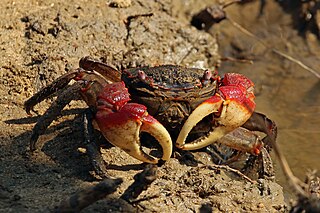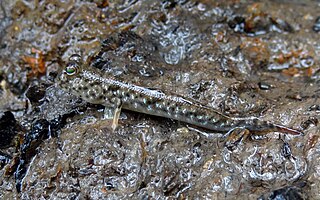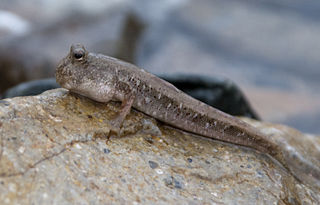
Amphibious fish are fish that are able to leave water for extended periods of time. About 11 distantly related genera of fish are considered amphibious. This suggests that many fish genera independently evolved amphibious traits, a process known as convergent evolution. These fish use a range of terrestrial locomotory modes, such as lateral undulation, tripod-like walking, and jumping. Many of these locomotory modes incorporate multiple combinations of pectoral-, pelvic-, and tail-fin movement.

Mudskippers are any of the 23 extant species of amphibious fish from the subfamily Oxudercinae of the goby family Oxudercidae. They are known for their unusual body shapes, preferences for semiaquatic habitats, limited terrestrial locomotion and jumping, and the ability to survive prolonged periods of time both in and out of water.

The brownspotted grouper, also known as the brown spotted reef cod, brown-spotted rockcod, coral grouper or honeycomb cod, is a species of marine ray-finned fish, a grouper from the subfamily Epinephelinae which is part of the family Serranidae, which also includes the anthias and sea basses. It has an Indo-Pacific distribution but in the northern Indian Ocean this distribution is discontinuous. It forms part of a species complex with two closely related species in the genus Epinephelus.

The blacktip grouper, also known as the redbanded grouper, blacktipped cod, black-tipped rockcod, footballer cod, red-barred cod, red-barred rockcod, scarlet rock-cod or weathered rock-cod, is a species of marine ray-finned fish, a grouper from the subfamily Epinephelinae which is part of the family Serranidae, which also includes the anthias and sea basses. It is found in the tropical Indo-Pacific region. It is the type species of the genus Epinephelus.

Periophthalmus is a genus of fish in the family Oxudercidae, native to coastal mangrove wood and shrubland in the Indo-Pacific region, except for P. barbarus from the Atlantic coast of Africa. It is one of the genera commonly known as mudskippers. Periophthalmus fishes are remarkable for being able to live, temporarily, in open air where they feed on insects and small invertebrates; out of water they have limited motion abilities, such as jumping. All Periophthalmus species are aggressive and territorial.

Like humans and other animals, fish suffer from diseases and parasites. Fish defences against disease are specific and non-specific. Non-specific defences include skin and scales, as well as the mucus layer secreted by the epidermis that traps microorganisms and inhibits their growth. If pathogens breach these defences, fish can develop inflammatory responses that increase the flow of blood to infected areas and deliver white blood cells that attempt to destroy the pathogens.

The Southern Africa mangroves are mangrove ecoregion on the Mozambique's southernmost coast and the eastern coast of South Africa.

The Atlantic mudskipper is a species of mudskipper native to fresh, marine, and brackish waters of the tropical Atlantic coasts of Africa, including most offshore islands, through the Indian Ocean and into the western Pacific Ocean to Guam. The Greek scientific name Periophthalmus barbarus is named after the eyes that provide the Atlantic mudskipper with a wide field of vision. The Atlantic mudskipper is a member of the genus Periophthalmus, which includes oxudercine gobies that have one row of canine-like teeth.

The shuttles hoppfish or shuttles mudskipper is a species of mudskippers native to fresh, marine and brackish waters of the northwestern Pacific Ocean from Vietnam to Korea and Japan. This species occurs in muddy estuaries, tidal flats and swamps and marshes and is capable of remaining out of the water for up to 60 hours so long as it is kept moist. This species can reach a length of 10 centimetres (3.9 in) TL. This species can also be found in the aquarium trade and is also used in traditional Chinese medicine.

The slender mudskipper is a species of mudskippers native to marine and brackish waters of the eastern Indian Ocean and the western Pacific Ocean where it is an inhabitant of the intertidal zone, capable of spending time out of water. This species can reach a length of 4.5 centimetres (1.8 in) SL.

The New Guinea mudskipper is a species of mudskippers native to fresh and brackish waters along the coasts of Australia and Indonesia. This species occurs in estuaries and tidal creeks as well as mangrove forests and nipa palm stands This species can reach a length of 8 centimetres (3.1 in) SL.

The common mudskipper is a species of mudskipper native to marine and brackish waters of the Indo-Pacific from eastern Africa to Samoa. This species can be found in mangrove forests where it spends most of its time out of the water. This species can reach a length of 14.1 centimetres (5.6 in) SL. The common mudskipper can deal with the chronic temperatures of up to 37°C and a chronic low of 14°C. Larger individuals aggregate in exposed intertidal mudflats and tend to spend about 90% of their lifetime out of the water.

The yellowfin goatfish is a species of goatfish native to the Indian Ocean and the Pacific Ocean.
Platygobiopsis is a genus of gobies native to the western Pacific Ocean.

Epinephelus ongus, the white-streaked grouper, specklefin grouper, lace-finned rock-cod, specklefin rockcod, wavy-lined tock-cod, white-speckled grouper or white-spotted rock-cod, is a species of marine ray-finned fish, a grouper from the subfamily Epinephelinae which is part of the family Serranidae, which also includes the anthias and sea basses. It has a wide Indo-Pacific distribution and it is found in brackish waters as well as marine reefs.

Lethrinus atkinsoni, the Pacific yellowtail emperor,, Atkinson's emperor, reticulated emperor, tricky snapper, Tuamotu emperor, yellow morwong or yellow-tailed emperor is a species of marine ray-finned fish benomging to the family Lethrinidae, the emperor breams and emperors. This fish is found in the Western Pacific Ocean.

Lethrinus lentjan, the pink ear emperor, redspot emperor, purple ear emperor or purple-headed emperor, is a species of marine ray-finned fish belonging to the family Lethrinidae, the emperors and emperor breams. This fish is found in the Indo-Pacific region.

Lethrinus rubrioperculatus,the spotcheek emperor, red-eared emperor, red-ears, red-edged emperor, scarlet-cheek emperor, and spot cheek emperor, is a species of marine ray-finned fish belonging to the family Lethrinidae, the emperors or emperor breams. This species has a wide Indo-Pacific distribution.
Darwin's mudskipper is a relatively newly discovered mudskipper in 2004, so little is known about it. It is a brackish water ray-finned fish found in Australia along mud banks never far from mangrove trees. It is in the goby family Gobiidae. It is named after Charles Darwin because the holotype was collected in Darwin Harbour. Its greatest distinguishing characteristic from other mudskippers is its greatly reduced first dorsal fin in both sexes.
Opegaster is a genus of trematodes in the family Opecoelidae.

















